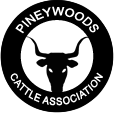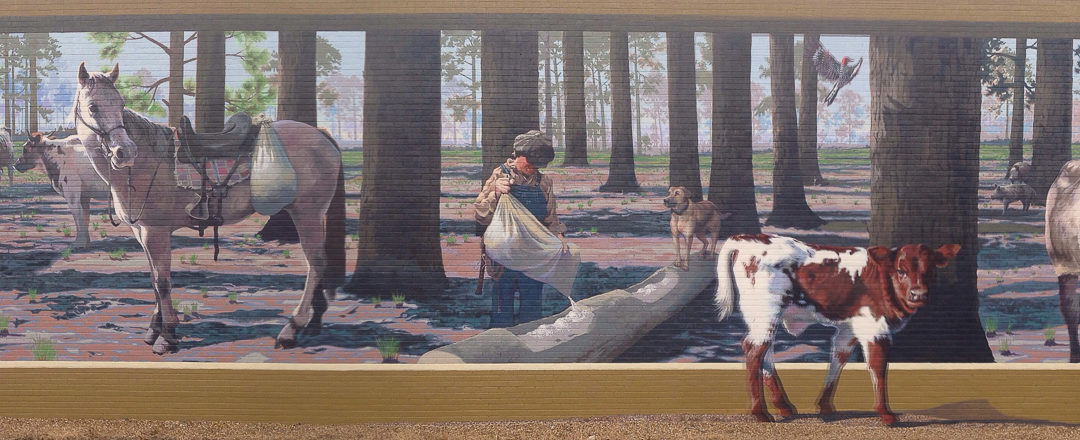Written by: Charles M. Simon, Covington County Extension Agent
The 80 x 14 foot mural before you was commissioned to help us to remember an era when the old Spanish based native cattle grazed the understory of the vast longleaf pine forest of the Gulf Coast. This old breed of cattle gave meat, hides, tallow and draft animals to a succession of owners from the Spanish cattle ranches and missions of Florida to the Southeastern Native Americans and finally to settlers of the newly formed United States.
The new mural is entitled “Twilight of an Era.” It depicts the time period of 1890-1910 AD. This is the time span when the “old growth” timber, predominately, longleaf pine, was rapidly being harvested opening up the land as a result. The Federal and State cattle tick eradication program began with the goal of eliminating the cattle tick from the Southern United States. The pace of new breeds of cattle being introduced picked up momentum as the “Tick Barrier” was gradually eliminated and the use of pastures and fences were being promoted by a new generation of agricultural progressives. The old free ranging “native cattle” were being cross-bred or eliminated completely from the farm. By the 1960’s, only a few of the pure native cattle survived on rangeland owned by families, like Dewey and Okla Barnes of Covington County, who still saw value in the breed.
The mural depicts a young boy “salting” his families’ free ranging native cattle. The old growth longleaf pine forest has had its understory “freshened” by a recent burn. The cattle are grazing new growth wiregrass, bluestem and other native grasses along with other recovering understory plants. The cattle are also “marked” by having their ears cut as calves in specific ways to denote ownership. Brands were also used but curiously not as much in Covington County. Ear “marking” was easier, permanent and done when the young calves were caught. The type mark and brand chosen were registered in one’s name at the local Courthouse. Today, cattle ear marks are no longer recognized as a mark of ownership. Only hot brands and ear tattoos are now recognized by the State of Alabama.
The young boy’s horse, carrying a surplus McClellen saddle and old quilt used as a pad, with the family “cur” dog are looking on as he pours coarse salt into a “lick log”. These “lick logs” had hollowed out trough cavities that were filled with the coarse salt which was essential to the cattle and used to keep them in an area. The family’s dog is an example of an all-purpose farm “cur” dog that was used for hunting, gathering and/or “catching” of cattle. These dogs used their canine fierceness to intimidate cattle to bunch together or force straying cattle back to the group so they may be driven to another location. These dogs could also grab the straying cattle by the muzzle or ear for additional control. Examples of these dogs are Blackmouth curs, Catahoula curs, Mountain curs or any other mixed breed cur-like dogs that were trained to do this type work.
The mural is not only a colorful illustration of the lifestyle and material culture of a people but also tells a story of a type of forest range management that used fire and cattle grazing to provide income to rural people that were here a century ago. Our history along the Gulf-Coast was not of the “Plantation South” but of small independent “yeoman” farmer/stockman who made their living utilizing the resources that the Longleaf Pine Forest provided. A distinct culture arose and thrived for generations. Hopefully, their contributions to our County and Region will not be forgotten.
Today, many see the need to bring back the longleaf pine to its rightful prominence in our southern forestlands along with the original natural understory that gave the term “vast grasslands under forest” that early travelers through the region described. Longleaf pine forests are being replanted and with it is a return of prescribed fire used liberally for managing timber growth and understory restoration. Also, new groups of enthusiasts are trying to save the old lines of native cattle from disappearing. Today, these cattle are called “Cracker Cattle” and “Pineywood Cattle” depending on the family linage.
Some cattle producers still allow limited access to their forestlands for shade, water and undergrowth control. Some have even begun using a proven forest/pasture combination called “Silvopasture”. This land management technique uses widely spaced pines that allow a significant amount of sunlight to support a “pasture” of bahiagrass or bermudagrass to grow beneath the pine canopy. Silvopasture allows a long term investment in pine trees and a short term cash flow from cattle.
“It seems to have come back in full circle”!!
Finally, a questions that is asked by many, “Why, is the calf out of the mural?’ If you raise cattle you know! It has to do with calves and fences.
The mural was made possible by the contributions from The Alabama State Council on the Arts, Covington County Cattleman Association, the Covington County Forestry Committee, The Solon and Martha Dixon Foundation, Dr. and Mrs. James Barnes, Mr. Albert Cravey and in memory of Charles (Chas) H. Simon.

